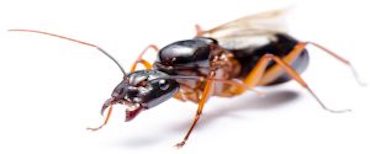Carpenter Ant’s
Although carpenter ants do not digest wood, they still cause considerable damage to wood structures. They bite or chew wood away from structures and make little tunnels so that they can make room for the queens eggs. REQUEST A QUOTE click here: Signs that you may have carpenter ants are wood shavings in areas they should not be. These shavings are usually at the mouth of the entrance to a carpenter ant nest. Carpenter Ants are usually attracted to pet foods, meat and anything that might be sweet. They do not transmit diseases. Unfortunately by then it’s too late to avoid costly repairs.

The damage that can be created by carpenter ants can be catastrophic if not caught in time. These relentless little wood carpenters do not care about your home and only have one mission; to make tunnels and holes in your wood beams through out your homes and businesses.
These ants are sneaky and rarely seen until they have destroyed something. They do not discriminate from one structure to another and will accomplish their mission or die trying.
Carpenter ants claim the title of one of the largest ants in the United States. Typically they range from 3 to 13.5mm long and are black in color, but often seeing red or yellow color combinations.
There are flying or winged carpenter ants as well as wingless ones. Flying male carpenter ants die after mating, while the females just lose their wings. It can takes up to three to six years to establish a large and solid colony. The life span of a carpenter ant is estimated around 6 to 12 weeks from egg to adult. Cold weather can impact the development time of carpenter ants for up to another 10 months of life.
The main role of the carpenter ant queen is to lay eggs and the main responsibility of the worker ants is to cultivate and protect those eggs.
Bowco is a family owned and operated company and has been servicing thier customers since 1932.
